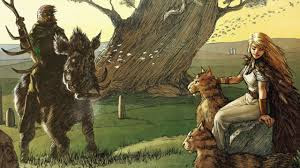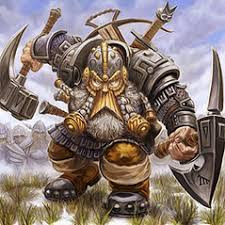Our forefathers imagined the infinities of space to be a profound abyss, to which they gave the name Ginnunga-gap; on one of its confines there were icy frosts and mists; on the other, flame and heat. The frozen reaches were known as the Home of Fogs, or Niflheim; the torrid region as Muspellsheim, which may perhaps be rendered, the Home of Desolation. As the ice of Niflheim gradually melted away before the heat of Muspellsheim, there flowed forth from Niflheim into Ginnunga-gap chill streams of venom (the Élivágar), and yet the animating beams from Muspellsheim called the first living beings into life: a prodigious Giant (jotunn), called Ymir or Aurgelmir, and the cow Audhumla, from whose milk he drew sustenance. From Ymir in turn sprang other Giants, and thus he became the progenitor of all that evil race. The cow Audhumla likewise brought about life anew by licking the icebound boulders of salt. In this manner Buri came into being; his son Borr, with Bestla, daughter of the Giant Bolthorn, had three sons, named Odin, Vili, and Ve. These sons of Borr were good and fair to see; they became the forebears of the race of the Æsir.
 |
| The Giants |
When the descendants of Ymir had multiplied beyond number, the sons of Borr put Ymir to death; in his blood all of the Giants were drowned except Bergelmir, who with his wife saved himself by means of a boat. The Æsir thus failed in their attempt to exterminate the race of Giants, and Bergelmir’s kindred grew to a mighty host. The Giants, or Jotuns, were also known by the names Thursar (pursar), Rime-Thursar (hrímpursar), Ettins (risar), Cliff-Ettins (bergrisar), and Trolls (troll); they persisted in the most evil courses. From the body of Ymir the sons of Borr made earth, sky, and sea. The body itself became the earth, the bones became mountains and stones, the hair became trees and grass, the skull became the vault of heaven, the brain became clouds, and the maggots in Ymir’s body became small Dwarfs, who dwelt beneath the earth’s surface and in rocks, and who lived on a better footing with the Giants than with the Æsir.
Odin, Vili, and Ve, the sons of Borr, were at first the only Æsir. Not content with shaping inanimate nature, they brought to life sentient beings as well, both men and animals. The first human pair, Ask and Embla, they created from two trees. Odin gave them breath, Vili gave them soul or understanding, and Ve (Lodur) gave them bodily warmth and color. From these two sprang the entire race of men.
 |
| Vanir |
The sons of Borr likewise created the celestial bodies. To this end they employed the sparks that flew into space out of Muspellsheim. The sun and the moon were placed each on its wain, and each wain was drawn by two horses; the horses of the sun were named Arvak and Alsvin. Before the sun stands the shield Svalin. As drivers of the wains were appointed the two beautiful children of Mundilfari, called Sun and Moon. Mundilfari was so proud of the two that he had named his daughter after the sun and his son after the moon; as a punishment the Æsir gave the children the task of guiding the wains of the sun and the moon. Moon once carried away from the earth two small children just as they left the well Byrgir carrying the cruse Sœg slung from their shoulders on a pole called Simul. The two children were named Bil and Hjuki, and their father’s name was Vidfinn. Since that time they have followed the moon in his course.
The Giants or the Rime-Thursar continued without ceasing to disquiet the Æsir and disturb their labors. A hideous Giantess, mother of a great brood of Giant werewolves, bore among the others two called Skoll and Hati, who took up the pursuit of Sun and Moon, to devour them. Sun and Moon therefore must needs make haste in their journey across the heavens; yet in the end their pursuers will overtake them. Hati was the more forbidding of the two; he was known also as Manigarm, or the Moon- Hound. Toward the race of men the Giants were so ill-disposed that the Æsir found themselves compelled to build from the eyebrows of Ymir a great defensive fortress encompassing the midmost region of the earth. The fortress and all that it contained bore the name Midgard; beyond its confines lay Jotunheim. In the centre of the universe the Æsir established their own dwelling, Asgard; there Odin had his own seat, Lidskjalf, from which he might survey the whole universe, both the heavens and the earth, and see all that happened there. The race of the Æsir here grew to a goodly number; Odin particularly had many children.
 |
| Elves |
Aside from the Æsir, the Dwarfs, and the Giants, our forefathers peopled the universe with other supernatural beings, such as the Vanir and the Elves. To the Vanir, dwelling in Vanaheim, the direction of the forces of nature seems particularly to have been attributed. Once upon a time, so the story runs, hostilities arose between the Æsir and the Vanir; the dispute ended with a treaty of peace, the terms of which prescribed an exchange of hostages. The Æsir delegated Hœnir; the Vanir delegated Njord, who in this way came to be numbered among the Æsir. The other deities who came from the Vanir were Frey and Freyja. Of the Elves, beings who associated preferably with men, some were good and some were evil. The good Elves, called Bright-Elves (ljós-alfar), who were brighter than the sun, had their abode in Alfheim; the evil Elves, called Dark-Elves (svart-alfar, døkk-alfar), were blacker than pitch, had their homes beneath the surface of the earth, and so are often confused with the Dwarfs.
Ebook Banner
Essential Reads: Engaging Books You Can't Miss!




 Bilingual Vietnamese Fairy Tales
Bilingual Vietnamese Fairy Tales
 Vietnamese Fairy Tales Collection
Vietnamese Fairy Tales Collection
 Shan Hai Jing
Shan Hai Jing
 The 72 Spirits of Solomon
The 72 Spirits of Solomon
Comments
Post a Comment